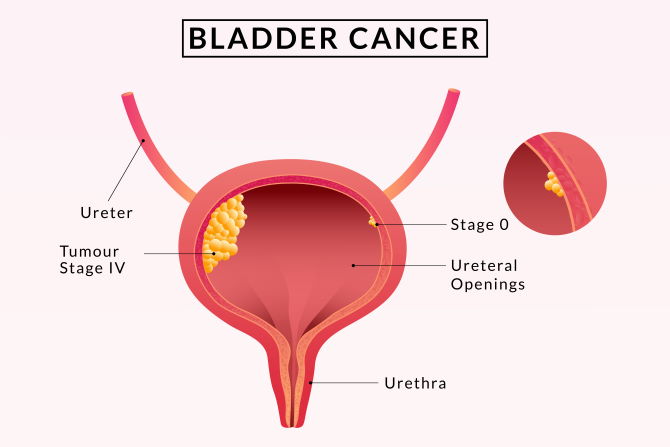Uncovering Critical Gender Distinctions in Bladder Cancer:
As a widespread genitourinary malignancy, bladder cancer demonstrates a higher propensity for the male population in terms of incidence rates. However, as research in this field progresses, the notion of bladder cancer as a “man’s disease” continues to fade. Emerging evidence reveals crucial clinical and biological distinctions between how this complex cancer affects men and women. By acknowledging these variances, we can pave the path for screening protocols, prevention strategies and treatment plans tailored to the unique needs of each patient based on gender-specific risk factors and responses.
The Gender Gap in Bladder Cancer Rates:
Epidemiological patterns over decades consistently display higher bladder cancer rates among men compared to women. According to recent global estimates, age-standardized incidence rates stand at 9.6 per 100,000 in men versus 2.4 per 100,000 in women – equating to nearly a 4:1 ratio. However, focusing solely on aggregate data obscures a deeper understanding of the variables influencing individual risk across genders.
Earlier Age of Onset Among Men:
In tandem with overall higher lifetime incidence, men tend to receive a diagnosis of bladder cancer at a slightly earlier age than women. The average age of initial bladder cancer detection is approximately 73 years in men compared to an average of 74 years old in women.
Behavioural Risk Factors – the Smoking Connection:
The prominent risk factor of cigarette smoking is more prevalent among men versus women across global populations– likely explaining a significant portion of the gender skew in bladder cancer rates. Male smokers face an estimated 2-6 times higher relative risk compared to female smokers although these rates have started to become similar across both genders. The exact interplay between gender, smoking patterns, and bladder carcinogenesis warrants further investigation.
Occupational Exposure Differences:
Beyond smoking, higher rates of occupational exposure to aromatic amines and polycyclic hydrocarbons among male workers in industries like rubber, leather, printing, and textiles also elevate bladder cancer risk substantially.
Hormones, Menopause and Risk:
The impact of reproductive hormones on bladder cancer development risk generates great interest. Estrogen and testosterone influence transitional cell carcinogenesis via receptor-mediated pathways. Post-menopause, decreasing estrogen levels associate with increased bladder cancer risk in women. Hormone signalling likely interacts with genetic and environmental cues in determining overall risk profiles.
Genetic Mutations and Biological Subtypes:
Ongoing efforts explore relationships between hormonal differences, chromosomal aberrations and genetic mutation patterns distinguishing male and female bladder cancer. For example, FGFR3 mutations occur more frequently in tumors with lower stage and grade – typical features more commonly seen among females. Further genetic mapping aims to unlock personalized prevention and treatment approaches.
Barriers to Early Detection in Women:
Due to overlapping urinary symptoms, bladder cancer signs in females often attribute to benign causes like UTIs initially – leading to missed opportunities for early intervention. It has been observed that even though bladder cancer is less prevalent amongst women, when compared to men – women are diagnosed at a more advanced stage. Enhancing screening for high-risk, elderly females improves early detection. Optimizing awareness of risk factors among women and healthcare providers mitigates delays in bladder cancer diagnosis.
Multifaceted Treatment Considerations:
Bladder-sparing approaches aim to preserve quality of life when reasonable, especially for low-grade non-invasive tumors. However, women experience higher rates of bladder reconstruction complications after partial cystectomy. Radiation therapy tolerance also varies between sexes. Chemotherapy effectiveness relies heavily on genetic markers – still under exploration across genders. Designed clinical trials enhancing knowledge on all treatment modalities for both sexes remain limited but necessary moving forward.
Emphasizing Education and Preventative Steps:
Elevating public awareness about bladder cancer risk factors amongst genders serves as a catalyst for prevention. Encouraging smoking cessation, increased water intake and reducing exposure to industrial chemical carcinogens empower individuals. Early diagnosis by screening those at high-risk improves treatment efficacy. Multipronged awareness campaigns make these inroads possible.
The Future of Gender-based Precision Medicine:
By acknowledging key gender differences – not just in rates but also tumor biology, hormonal responses and genetics – researchers edge closer towards personalized prevention and treatment grounded in one’s biological sex. Moving forward, expanding our knowledge of sex-specific dimensions in bladder cancer paves the road to precision intervention
Only through this gender-conscious approach can we develop screening protocols specific to risk profiles in men and women. And by unravelling the underlying genetic aberrations influencing carcinogenesis in each sex, we can reveal targeted therapies catered to the unique characteristics of bladder tumors in males and females. Understanding critical gender distinctions takes us one step closer to mitigating the toll of this formidable foe worldwide.
Conclusion:
Understanding the multifaceted nature of bladder cancer in men and women is instrumental in developing comprehensive strategies for prevention, early detection, and treatment. Through collaborative research, increased awareness, and personalized medical approaches, we can strive towards a future where bladder cancer is effectively managed and its impact mitigated.

Dr Ragavan N Senior Consultant - Uro Oncology-





.png)




